
Data Which words function as auxiliaries?
as "helping verbs", i.e., the ones that take VP complements
will, would, can, could, shall, should, may, might, must,
have (perfect), be (passive); do; dare, need
as "main verbs", i.e., the ones that take non-VP complements
have (have money), be (be friendly, be a friend, be at home)
The so-called ordering problem
Chomsky's solution:
McCawley response:
Auxiliaries treated as raising-to-subject verbs. (Ross 1969)
Properties of individual auxiliaries: inherent and combinatorial. (McCawley 1971; McCawley 1988, chapter 8)
For independent reasons we need to treat auxiliaries (i.e., the ones that take verbal complements) as ordinary complement-taking verbs of the "Raising" type. In saying that they take an "srs -" complement we mean that the "Coinstantiation" construction has to be called on: the subject of the complement has to be co-construed as one of the arguments in the higher predicate. Further, in describing the subject as of the "theta null" type, we require it to control the subject of the complement.
The values in this first diagram marked by double quotation marks are the values by which individual auxiliaries can differ from each other. This is true of the inflectional categories that the auxiliaries can assume, the lexical head (of course), and the semantics. It's also true of certain requirements of the verbal complement: whether or not it can be headed by an auxiliary, what its morphology must be, and what its semantics has to be, in cases where there are some constraints.
General Characteristics of Auxiliaries

In the entries for which the variable values are filled in, you will find upper-case labels, just to highlight the changes.
The Modals (represented by "will")
We can look now at the entry for the modal WILL. We noticed about this auxiliary that if it's present, it always occurs first, and that it is always finite. These facts are accounted for by the feature "vif fin": it is finite. Since a finite sentence is headed by a finite verb, and the heads of complement VPs are never finite, both the form and the position get accounted for. We also noted that it always has a complement whose head verb is in the "base" or "bare stem" form; this fact is represented by the feature "vif bse". There are no constraints on the syntactic kind or the semantics of the complement, and so the semantics of the complement is left unspecified.
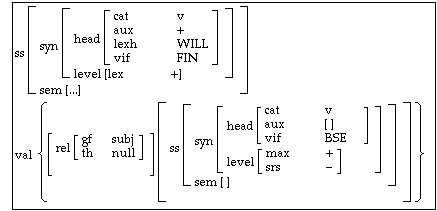
All other modals will have the same representation; they will differ, of course, in just how the semantics is filled in; and they will differ in respect to the kinds of contractions they permit, either with the preceding pronoun subject ("he'll" in the case of "will") or with a following negation morpheme ("won't" in the case of "will").
Perfect Auxiliary "have"
The auxiliary "have" exists as the means of presenting the "perfect" aspect. The head verb of its complement is in the past participial form, hence the notation: vif pap.
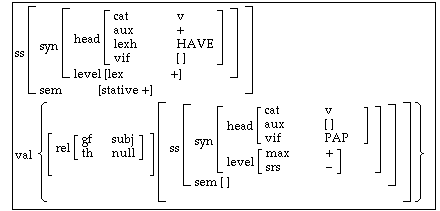
The semantics of the perfect aspect: REFERENCES HERE, EVENTUALLY.
A clause in perfect aspect is "stative".
Progressive Auxiliary "be"
The progressive aspect is represented by the auxiliary "be" and the present participial inflection on the head of the complement verb.
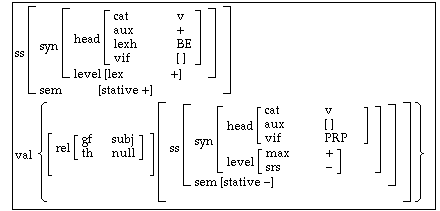
We state here that a verb in progressive aspect is stative, but that it takes a non-stative complement. The reason for this will come up in the treatment of the GOT construction below.
Passive Auxiliary "be"
Passive clauses make use of the auxiliary "be" whose complement has two characteristics: it is in passive voice (hence something like "seen the children" rather than "seen by the polic"); and its head verb is in the past participial form.
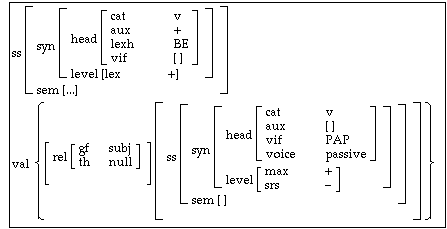
All of the other auxiliaries looked at so far can be followed by (i.e., can take as complements VPs headed by) auxiliaries; but the passive auxiliary's complement must be headed by a "real" verb. This, of course, is because it must be in the passive voice, and only transitive verbs participate in passivization.
Tense-Bearing "do"
The transformational treatment of "do" is as something that is introduced into the VP whenever an auxiliary is needed, e.g., for emphasis, negation, inversion, VP-deletion, etc. The function of "do" is to serve the auxiliary function just in case there is no other auxiliary around to do that. Hence it happens that the auxiliary "do" is always finite (there's nothing else to bear the tense") and it's never followed by an auxiliary. In short, this is the only auxiliary that cannot be preceded or followed by an auxiliary.
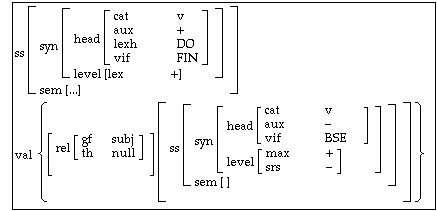
no modal of modal: modals are finite, require bare stem
no progressive of progressive: is stative, require non-stative
no passive of passive: is auxiliary, requires non-auxiliary
no perfect of perfect: semantic interpretation? (setting
"E" before "R" for complement for which their relative
positions are not specified.
gaps (*musted; *amn't; *mayn't)
contraction, two kinds (with subject, with not)
emphasis, ellipsis, inversion; negation; have got; tag questions (three kinds); aux-comp omissiont; aux-comp fronting;
The following diagram is the "box-in-box" construction that is supposed to account for the way in which some uses of the verb "have" can be "extended" with the semantically empty word "got".
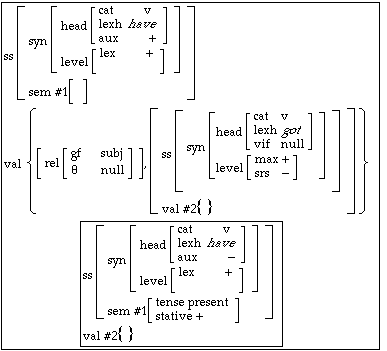
The construction is designed to account for the acceptable and unacceptable paraphrase relations seen in the following list.
The phenomenon of GOT-extension concerns several uses of the verb HAVE, hence it needs to leave its semantics and valence as a variables. The basic observations are these.
The ss|syn|head path in the upper left corner of the diagram tells us that the lexical verb identified in this construction is HAVE and that it is an auxiliary.
The ss|syn|head path in the smaller box at the bottom tells us that the input lexical item is a non-auxiliary (that is, is marked "aux -") verb HAVE.
The two ss|sem paths in the upper left corner and in the small box both lead to feature structures linked by the unification index #1. This tells us that the semantics of the GOT-extended HAVE is the same as that of the input HAVE, but also that it is limited to stative uses and to the present tense.
Now look at the valence description in the middle of the large box. This tells you that there is a theta-null subject (hence GOT-extended HAVE is a "raising" verb, as with other auxiliaries). The other argument is a "VP" headed by the word GOT. The path ss|syn|head tells us that this lexical head is the form GOT, classified as a verb, with null inflection. That means only that there's no particular reason to assign it any of the standard inflections. The path ss|syn|level leads to the information that this constituent is a VP ("srs -" = "subject requirement not satisfied").
Now notice that the valence of the input HAVE and the valence of the GOT are identical.
Commentary.